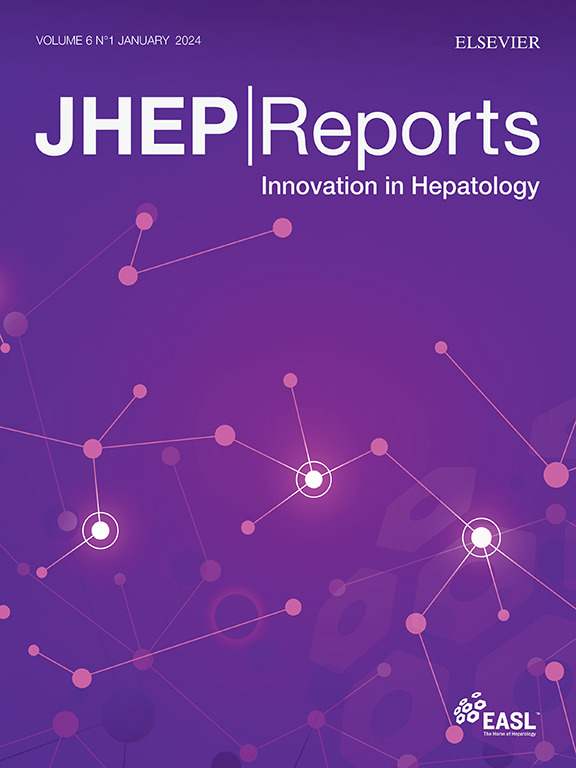肝移植后自身免疫性肝炎胆汁淤积变异综合征的复发影响移植物和患者的生存
IF 9.5
1区 医学
Q1 GASTROENTEROLOGY & HEPATOLOGY
引用次数: 0
摘要
背景,有相当比例的变异综合征(VSs)患者,即自身免疫性肝炎/原发性胆管炎或自身免疫性肝炎/原发性硬化性胆管炎,尽管接受了治疗,但仍需要肝移植(LT)。疾病复发的频率和对移植物存活的影响尚不清楚。这项国际、多中心、回顾性研究的目的是评估与复发相关的危险因素以及肝移植后疾病复发对移植物和患者生存的影响。方法我们评估了来自北美、南美、欧洲和亚洲33个中心的166例接受肝移植治疗VS的患者。通过分析肝移植前后的临床数据、肝移植后前12个月内的生化数据以及肝移植后的免疫抑制数据,通过组织学和影像学诊断来确定自身免疫性疾病复发风险较高的患者。用半马尔可夫模型计算移植后的累积概率和总生存率。结果19例(61%)复发的自身免疫模式与原发VS相似。自体免疫性肝病(rALD)在移植后5年和10年分别有23%和33%的患者复发。肝移植术后12个月碱性磷酸酶升高(风险比[HR] 1.60, 95%可信区间[CI] 1.13-2.25, p <0.01)和丙氨酸转氨酶升高(风险比[HR] 1.25, 95% CI 1.01-1.53, p = 0.03)和急性排斥反应(风险比[HR] 3.58, 95% CI 1.60 - 7.73, p <0.01)与较高的肝移植复发风险相关,而使用predniso(lo)ne与降低风险相关(风险比[HR] 0.30, 95% CI 0.14-0.64, p <0.01)。在对12个月的丙氨酸转氨酶和碱性磷酸酶进行调整后,发现泼尼索(lo)的使用与复发性疾病独立且负相关。在具有时间相关协变量的多变量Cox回归分析中发现rALD与移植物损失和患者生存显著相关。复发性VS患者的5年和10年移植存活率分别为68%和41%,而无复发性VS患者的5年和10年移植存活率分别为83%和60% (p = 0.01)。复发性疾病患者的总生存率显著降低(p = 0.01), 5年和10年的事件概率分别为75%和49%,而无复发患者的事件概率分别为84%和60%。结论肝移植后发生ald的频率较高,且与肝移植后一年内肝酶升高和排斥反应有关。根据我们的数据,VS复发似乎与较差的移植物和患者生存有关。需要进一步的研究来探索预防VS复发或减轻其潜在影响的策略。影响和意义本研究探讨了自身免疫性肝病(rALD)在变异综合征(VSs)移植患者中的复发及其对移植物和患者生存的影响。研究结果揭示了rALD与较差的移植物和总体存活率之间的显著关联,强调了预防策略的必要性。这项研究对移植医生和医疗保健提供者至关重要,因为它强调了早期肝酶监测和量身定制的免疫抑制治疗对长期预后的影响。这些见解可以为更有效的肝移植后管理方案提供信息,潜在地改善患者预后。本文章由计算机程序翻译,如有差异,请以英文原文为准。

Recurrence of autoimmune hepatitis cholestatic variant syndromes after liver transplantation affects graft and patient survival
Background & Aims
A significant proportion of patients with variant syndromes (VSs), namely autoimmune hepatitis/primary biliary cholangitis or autoimmune hepatitis/primary sclerosing cholangitis, require liver transplantation (LT) despite treatment. The frequency of disease recurrence and the effect on graft survival are yet to be clarified. The aim of this international, multicentric, retrospective study is to evaluate the risk factors associated with recurrence and the impact of the disease recurrence after LT on graft and patient survival.
Methods
We evaluated 166 patients undergoing LT for VS in 33 centers in North America, South America, Europe, and Asia. Clinical data before and after LT, biochemical data within the first 12 months after LT, and immunosuppression after LT were analyzed to identify patients with a higher risk of recurrence of autoimmune disease based on a histological and radiological diagnosis. Cumulative probabilities of graft and overall survival after LT were calculated using a semi-Markov model.
Results
The autoimmune pattern of recurrence resembled the original VS in 19 cases (61%). Recurrence of autoimmune liver disease (rALD) after LT was observed in 23% and 33% of patients after 5 and 10 years, respectively. Increased alkaline phosphatase (hazard ratio [HR] 1.60, 95% confidence interval [CI] 1.13–2.25, p <0.01) and alanine aminotransferase (HR 1.25, 95% CI 1.01–1.53, p = 0.03) at 12 months after LT and acute rejection (HR 3.58, 95% CI 1.60–7.73, p <0.01) were associated with a higher risk of VS recurrence, whereas the use of predniso(lo)ne was associated with a reduced risk (HR 0.30, 95% CI 0.14–0.64, p <0.01). After adjusting for alanine aminotransferase and alkaline phosphatase at 12 months, the use of predniso(lo)ne was found to be independently and negatively associated with recurrent disease. The rALD was found to be significantly associated with graft loss and patient survival in the multivariate Cox regression analysis with a time-dependent covariate. The 5- and 10-year probabilities of graft survival were 68% and 41% in patients with recurrent VS compared with 83% and 60% in patients without recurrent disease, respectively (p = 0.01). The overall survival was significantly reduced in patients with recurrent disease (p = 0.01), with event probability at 5 and 10 years of 75% and 49% vs. 84% and 60% in patients without recurrence, respectively.
Conclusions
rALD after LT is frequent and is associated with elevation in liver enzymes within the first year after LT and rejection episodes. According to our data, VS recurrence appears to be associated with poorer graft and patient survival. Further studies are needed to explore strategies that can prevent VS recurrence or mitigate its potential impact.
Impact and implications
This study investigated the recurrence of autoimmune liver diseases (rALD) in patients transplanted for variant syndromes (VSs) and its effect on graft and patient survival. The findings reveal a significant association between rALD and poorer graft and overall survival, highlighting the need for preventive strategies. This research is crucial for transplant physicians and healthcare providers, as it underscores the impact of early liver enzyme monitoring and tailored immunosuppressive therapy on long-term outcomes. These insights can inform more effective post-LT management protocols, potentially improving patient prognosis.
求助全文
通过发布文献求助,成功后即可免费获取论文全文。
去求助
来源期刊

JHEP Reports
GASTROENTEROLOGY & HEPATOLOGY-
CiteScore
12.40
自引率
2.40%
发文量
161
审稿时长
36 days
期刊介绍:
JHEP Reports is an open access journal that is affiliated with the European Association for the Study of the Liver (EASL). It serves as a companion journal to the highly respected Journal of Hepatology.
The primary objective of JHEP Reports is to publish original papers and reviews that contribute to the advancement of knowledge in the field of liver diseases. The journal covers a wide range of topics, including basic, translational, and clinical research. It also focuses on global issues in hepatology, with particular emphasis on areas such as clinical trials, novel diagnostics, precision medicine and therapeutics, cancer research, cellular and molecular studies, artificial intelligence, microbiome research, epidemiology, and cutting-edge technologies.
In summary, JHEP Reports is dedicated to promoting scientific discoveries and innovations in liver diseases through the publication of high-quality research papers and reviews covering various aspects of hepatology.
 求助内容:
求助内容: 应助结果提醒方式:
应助结果提醒方式:


